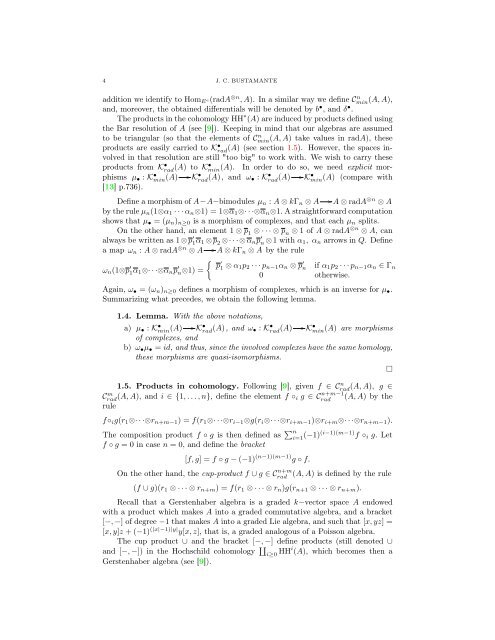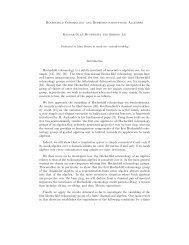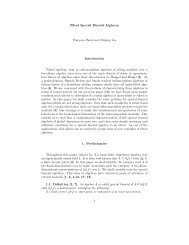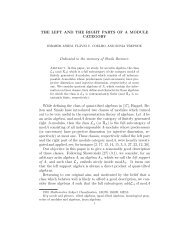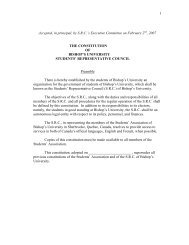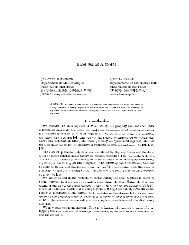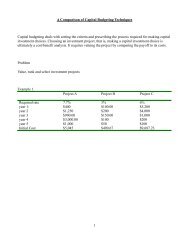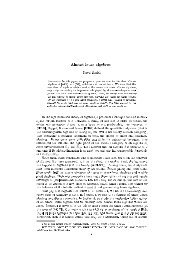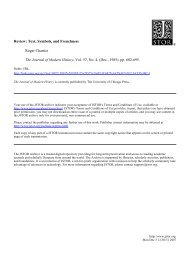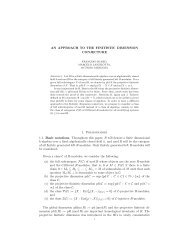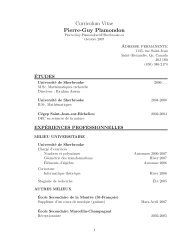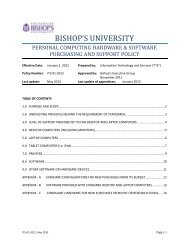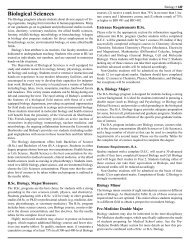The cohomology structure of string algebras
The cohomology structure of string algebras
The cohomology structure of string algebras
You also want an ePaper? Increase the reach of your titles
YUMPU automatically turns print PDFs into web optimized ePapers that Google loves.
4 J. C. BUSTAMANTE<br />
addition we identify to Hom E e(radA ⊗n , A). In a similar way we define Cmin n (A, A),<br />
and, moreover, the obtained differentials will be denoted by b • , and δ • .<br />
<strong>The</strong> products in the <strong>cohomology</strong> HH ∗ (A) are induced by products defined using<br />
the Bar resolution <strong>of</strong> A (see [9]). Keeping in mind that our <strong>algebras</strong> are assumed<br />
to be triangular (so that the elements <strong>of</strong> Cmin n (A, A) take values in radA), these<br />
products are easily carried to K<br />
rad • (A) (see section 1.5). However, the spaces involved<br />
in that resolution are still "too big" to work with. We wish to carry these<br />
products from K<br />
rad • (A) to K• min (A). In order to do so, we need explicit morphisms<br />
µ • : K min • (A) K<br />
rad • (A), and ω • : K<br />
rad • (A) K min • (A) (compare with<br />
[13] p.736).<br />
Define a morphism <strong>of</strong> A−A−bimodules µ n : A ⊗ kΓ n ⊗ A A ⊗ radA ⊗n ⊗ A<br />
by the rule µ n (1⊗α 1 · · · α n ⊗1) = 1⊗α 1 ⊗· · ·⊗α n ⊗1. A straightforward computation<br />
shows that µ • = (µ n ) n≥0 is a morphism <strong>of</strong> complexes, and that each µ n splits.<br />
On the other hand, an element 1 ⊗ p 1 ⊗ · · · ⊗ p n ⊗ 1 <strong>of</strong> A ⊗ radA ⊗n ⊗ A, can<br />
always be written as 1 ⊗ p ′ 1α 1 ⊗ p 2 ⊗ · · · ⊗ α n p ′ n ⊗ 1 with α 1 , α n arrows in Q. Define<br />
a map ω n : A ⊗ radA ⊗n ⊗ A A ⊗ kΓ n ⊗ A by the rule<br />
{<br />
ω n (1⊗p ′ 1α 1 ⊗· · ·⊗α n p ′ p<br />
′<br />
n⊗1) = 1 ⊗ α 1 p 2 · · · p n−1 α n ⊗ p ′ n if α 1 p 2 · · · p n−1 α n ∈ Γ n<br />
0 otherwise.<br />
Again, ω • = (ω n ) n≥0 defines a morphism <strong>of</strong> complexes, which is an inverse for µ • .<br />
Summarizing what precedes, we obtain the following lemma.<br />
1.4. Lemma. With the above notations,<br />
a) µ • : K min • (A) K<br />
rad • (A), and ω • : K<br />
rad • (A) K min • (A) are morphisms<br />
<strong>of</strong> complexes, and<br />
b) ω • µ • = id, and thus, since the involved complexes have the same homology,<br />
these morphisms are quasi-isomorphisms.<br />
1.5. Products in <strong>cohomology</strong>. Following [9], given f ∈ Crad n (A, A), g ∈<br />
Crad m (A, A), and i ∈ {1, . . . , n}, define the element f ◦ i g ∈ C n+m−1<br />
rad<br />
(A, A) by the<br />
rule<br />
f◦ i g(r 1 ⊗· · ·⊗r n+m−1 ) = f(r 1 ⊗· · ·⊗r i−1 ⊗g(r i ⊗· · ·⊗r i+m−1 )⊗r i+m ⊗· · ·⊗r n+m−1 ).<br />
<strong>The</strong> composition product f ◦ g is then defined as ∑ n<br />
i=1 (−1)(i−1)(m−1) f ◦ i g. Let<br />
f ◦ g = 0 in case n = 0, and define the bracket<br />
[f, g] = f ◦ g − (−1) (n−1)(m−1) g ◦ f.<br />
On the other hand, the cup-product f ∪ g ∈ C n+m (A, A) is defined by the rule<br />
rad<br />
□<br />
(f ∪ g)(r 1 ⊗ · · · ⊗ r n+m ) = f(r 1 ⊗ · · · ⊗ r n )g(r n+1 ⊗ · · · ⊗ r n+m ).<br />
Recall that a Gerstenhaber algebra is a graded k−vector space A endowed<br />
with a product which makes A into a graded commutative algebra, and a bracket<br />
[−, −] <strong>of</strong> degree −1 that makes A into a graded Lie algebra, and such that [x, yz] =<br />
[x, y]z + (−1) (|x|−1)|y| y[x, z], that is, a graded analogous <strong>of</strong> a Poisson algebra.<br />
<strong>The</strong> cup product ∪ and the bracket [−, −] define products (still denoted ∪<br />
and [−, −]) in the Hochschild <strong>cohomology</strong> ∐ i≥0 HHi (A), which becomes then a<br />
Gerstenhaber algebra (see [9]).


